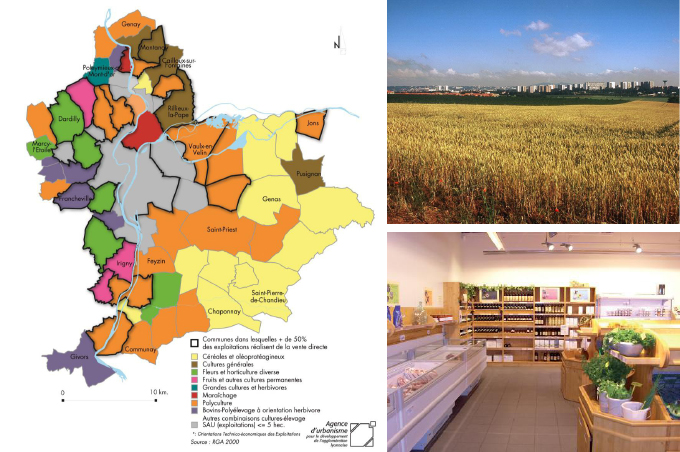Farmland protection program around Lyon: PSADER-PENAP
28th August, 2013
Contributor: Lyon
The PSADER-PENAP is a public policy leveraging on urban planning and funding to protect natural and farming areas, and to promote rural development and agricultural companies. It involves several levels of local authorities following the same objectives around Lyon’s urban area.
Concept/ Motivations
The urban area of Lyon counts 38 000 hectares (54% of the territory) of non-built space. About 14 000 ha are used by farms (3% in organic farming) in many sectors: animal farming, cereal farming, winegrowing, market gardening, horticulture, etc. Every year, an average of 300 ha of agricultural lands disappears due to urban sprawl and estate pressure.
The lost of agriculture and natural lands became a new issue during the last decades. Especially since the late 70’s, the way to consider the non-built land did evolve. From potential building areas, the farmland became a guarantee of quality of life and environment protection. More recently, beside the economic impact of agricultural companies (jobs), the mention of “nourishing areas” appeared in the local authorities’ rhetoric.
In the 90’, several levels of local authorities started to collaborate to go further in the protection and promotion of farming and natural areas. The PSADER-PENAP is the result of this collaboration. It’s a public policy toolkit defining a scope for actions in coordination with “urban planning authorities”, based on a diagnostic of the territory and a common funding.
The PSADER-PENAP might be upscaled, regarding the current match between existing tools and the evolution of the speech towards sustainable food.
Objectives:
- maintain the farming and natural areas around Lyon
- improve links between urban and rural communities
- protect and promote natural spaces, biodiversity and resources
Result
The PSADER-PENAP program:
Period: 2010-2016
Founds: € 4 million
Partners:
- the Region : Rhône-Alpes
- the Department: Rhône
- 3 urban communities including the Greater Lyon (72 cities)
Perimeter: 730 km2 (380km² non-built)
Specific partnership with main agriculture organisation for project engineering
3 strategic priorities with concrete actions:
1. Maintain a periurban sustainable agriculture (about 50% of the budget)
Examples of actions:
- Provide local food to schools canteens: work on public procurement, on the menus’ planning and support the farmers to reach this market (regroup, collective offer, etc…).
- Support the creation of collective points of sale, especially inside the city limits (intra-muros). Lately, some producers have been supported to reuse an ancient public covered market (Halle de la Martinière).
- Support the creation of an online map of all local street markets in the urban area. This tool gives information such as: address, schedule, administrative rules, equipments, facilities, advertising, etc. (http://www.geomarches.com/)
2. Improve links between urban, peri-urban and rural (about 10% of the budget)
Examples of actions:
- Set up a mobility plan for farm vehicles: work with the local roads department to spot problem areas and define a traffic plan.
- Develop a communication plan to highlight the agricultural jobs and the peri-urban situation
3. Protect and promote natural and farming areas, water resources, biodiversity and landscapes, prevent soil erosion or flood risks (27% of the budget)
Examples of actions:
- Partnership with the local authorities for rural estate management (SAFER). According to the law, they are allowed to buy any piece of agricultural land when it’s sold, in order to keep it as farmland (pre-emption). That’s why, they have a great influence on the agricultural land prices market.
- Maintain and preserve the “green corridor”
- Support the conversion of farmers to adopt environmentally friendly practices
Benefits
Governance: several levels of local authorities have launched a common tool
Environment: the tool preserves natural and farming lands on a long term perspective (30 years from now), eco-friendly practices
Economical: support agricultural economy
Gives to agriculture a real place in urban planning
Pro and Contra
Pro:
- Gives a frame for both the city and the NGOs
- Based on free commitment
- Process based on workshops
Contra:
- A Charter is (only) based on free commitment
- Small impact regarding the amount of allotments
- Purpose stays on social link more than sustainable food
- Doesn’t help to find new space for new gardens
What are the lessons learn to be used/transferred/implemented in the other partner cities?
The community gardens network, Le Passe-Jardins, is essential to help creation and development of community gardens and to create a link between users and the city;
The diagnostic of the community gardens was a great help to identify specificities and needs.
The collective writing work strengthens local governance
Question to the network
How could the community gardens growing food to feed the city? Is it a realistic vocation/interest? Do they not only exist to serve hobbies and social link?
How to find/develop new space for new gardens? Use private land? How to make sure to avoid privatisation of public space?
Could the gardeners to give the production to social grocery shops (legislation concerning health risks, etc)
How to encourage the allotments in the same way?
References:
Hélène FONFREDE, Territorial Development Dpt of Lyon: helene.fonfrede@mairie-lyon.fr
http://www.lyon.fr/page/cadre-de-vie/respirez-/cultiver-son-bien-etre.html
http://lepassejardins.fr/spip.php?page=sommaire
